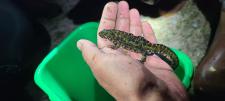Preserving the past, protecting the future: Historic village water tanks provide a lifeline for amphibians

New research highlights the surprising role of centuries-old water structures in protecting biodiversity in Portugal’s Peneda-Gerês National Park.
At Peneda-Gerês National Park, Portugal’s first protected area and its only national park, pristine ecosystems blend with traditional villages that have existed for generations. As rural life fades and many of these villages are largely abandoned, the communal laundry tanks, stone fountains, and irrigation channels that once sustained rural life remain as quiet features in a human-altered protected landscape.
"As natural habitats face increasing pressure, understanding and maintaining these man-made refuges may be crucial for conservation efforts, ensuring even highly modified landscapes can support vulnerable species", says Dr Jose Valdez from MLU and iDiv, lead author of the study. To determine whether the historic structures could support amphibian populations, the team led by Jose Valdez and Professor Henrique Pereira, a biologist at MLU and iDiv, conducted an extensive field study across villages in the park, including 162 bodies of water, including natural sites like ponds and streams, but also artificial structures, such as village tanks, fountains, and irrigation channels. The researchers recorded amphibian species richness, abundance, presence, and breeding activity to assess the ecological value of the bodies of water at each location.
An unexpected ecological opportunity
While natural streams and ponds typically supported a greater number of species, the study revealed that artificial water bodies played an unexpectedly vital and complementary role. Historic stone tanks, in particular, emerged as important habitats, with amphibians present in two-thirds of these tanks and a quarter of the tanks being used as breeding sites. Surprisingly, these tanks even supported a higher diversity of species compared to natural habitat types. The endemic species Marbled Newt (Triturus marmoratus) and Bosca’s Newt (Lissotriton boscai) were found breeding in these historic structures, often more frequently than in the nearby natural ponds or streams.
"Natural wetlands are becoming increasingly unpredictable due to climate change, and these tanks now provide stable, safe environments that are essential for the vulnerable eggs and larvae of local amphibian species", explains Jose Valdez.
Complementary, but not a replacement
While the research highlights the ecological role of artificial water bodies in Peneda-Gerês National Park, the team cautions that these man-made structures should not be seen as a replacement for natural habitats. Natural ecosystems, particularly pockets of water within streams and ponds, remain irreplaceable for many amphibian species. For example, the Iberian frog (Rana iberica) and Fire Salamander (Salamandra salamandra) were found nearly exclusively in natural water bodies. However, artificial habitats can serve as a crucial buffer in areas impacted by land abandonment, drought, and habitat loss.
"Peneda-Gerês is a rare landscape shaped by both nature and generations of village tradition," says Henrique Pereira, the study’s senior author and former director of the park. "Our findings reveal how this cultural legacy can play a critical role supporting local amphibian populations. By protecting these man-made structures alongside natural habitats, we don’t just preserve history, we can secure a future that preserves both its cultural heritage and its rich biodiversity within the park."
Study: Valdez J. W. et al. Traditional water structures in villages support amphibian populations within a protected landscape. Ecosphere (2025) doi: 10.1002/ecs2.70294

